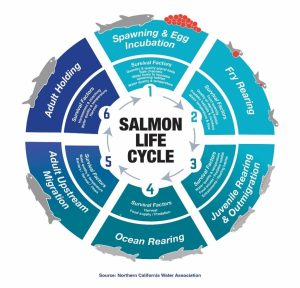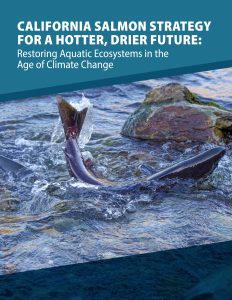By Todd Manley
On Tuesday, Governor Gavin Newsom’s administration released the “California Salmon Strategy for a Hotter, Drier Future: Restoring Aquatic Ecosystems in the Age of Climate Change.” This document outlines the administration’s broad strategy to recover California’s salmon populations, including the four runs of Chinook salmon that return to rivers and creeks in the Sacramento Valley to spawn.
We encourage you to read the new strategy. Categories of actions in the plan include: Remove Barriers and Modernize Infrastructure for Salmon Migration, Restore and Expand Habitat for Salmon Spawning and Rearing, Protect Water Flows and Water Quality in Key Rivers at the Right Times to Support Salmon, Modernize Salmon Hatcheries, Transform Technology and Management Systems for Climate Adaptability, and Strengthen Partnerships.
This approach and the action items are generally supported by the “Holistic Approach to Healthy Rivers and Landscapes” that water agencies in the Sacramento Valley and our many partners (including a collaboration of state fisheries and water management agencies and conservation partners) are advancing to recover fish species in the Sacramento Valley, recreate floodplains and other Pacific Flyway habitat for birds and other species through land and water management actions, and habitat for other wildlife while protecting communities and sustaining farming in the region.
Our healthy rivers and creeks depend upon on a sufficient volume of water interacting with a healthy landscape at the right time and place to deliver water for multiple benefits and approximate the habitat patterns to which the native flora and fauna are adapted. Our approach includes a portfolio of actions in every river reach designed to provide flows with function–the sufficient water necessary to reactivate the landscape-scale patterns of biophysical habitat conditions that robust, resilient populations of salmon (and other native fish, bird, and wildlife populations) depend upon. Our goal for this Holistic Approach is to provide salmon with a riverscape that they recognize.
For the past several decades there has been a regulatory focus on one species or even one-life-stage for salmon, without the desired improvement in fisheries or aquatic health. Scientists are pointing the way forward for a new ridgetop to river mouth water management approach that is essential for the recovery of the four runs of salmon in the Sacramento Valley. The Sacramento Valley Salmon Recovery Program will continue to be used to coordinate and prioritize salmon recovery actions with a focus on collaborative actions to advance the NOAA “Species in the Spotlight” and Fisheries Recovery Plan, the new California Salmon Strategy for a Hotter, Drier Future, the California Natural Resources Agency’s Sacramento Valley Salmon Resiliency Strategy and Salmon Action Plan. Every water management action from ridgetop to river mouth is necessary to improve conditions for every freshwater life-stage of salmon as they migrate up and down the river systems, and to avoid a weak link in the salmon life-cycle. The Holistic Approach, with collaborative actions on each of these elements and river segments, is the best opportunity for salmon recovery in the Sacramento Valley.
The leaders living and working in the Sacramento Valley are embarking on a once-in-a-generation opportunity to advance a holistic and comprehensive approach for fisheries by aligning the current leadership, science, available funding, and a devotion to “give salmon a chance” by improving freshwater conditions for salmon throughout the Sacramento Valley. Our goal the next several years is to broaden the focus on salmon to include all life stages, rather than focus entirely on temperature management issues on the upper Sacramento River. This will focus on working with the agencies to further unconfine the Sacramento River System and activate the landscape as the best solution for fish and wildlife, including floodplain reactivation, improving access and habitat on Butte Creek and Battle Creek, reintroduction opportunities above Shasta Dam, and improved hatcheries. These actions are part of a concerted effort to improve all freshwater life-stages for salmon: spawning gravel, temperature management for incubation, rearing habitat, migratory corridors, and nourishment, as well as decreasing predation impacts.

This holistic approach is described in detail here and offers a macro-view of the Sacramento Valley, showing the comprehensive efforts underway–from ridgetop to river mouth–to improve freshwater conditions for each life-stage of all four-runs of Chinook salmon. This approach and the actions throughout the region are all designed to restore ecosystem function of the landscapes and riverscapes, while concurrently helping secure water supplies for communities, farms, other fish and wildlife, recreation, and hydropower. We look forward to implementing an action plan to support the new Salmon Strategy with the state and federal agencies and conservation partners.






